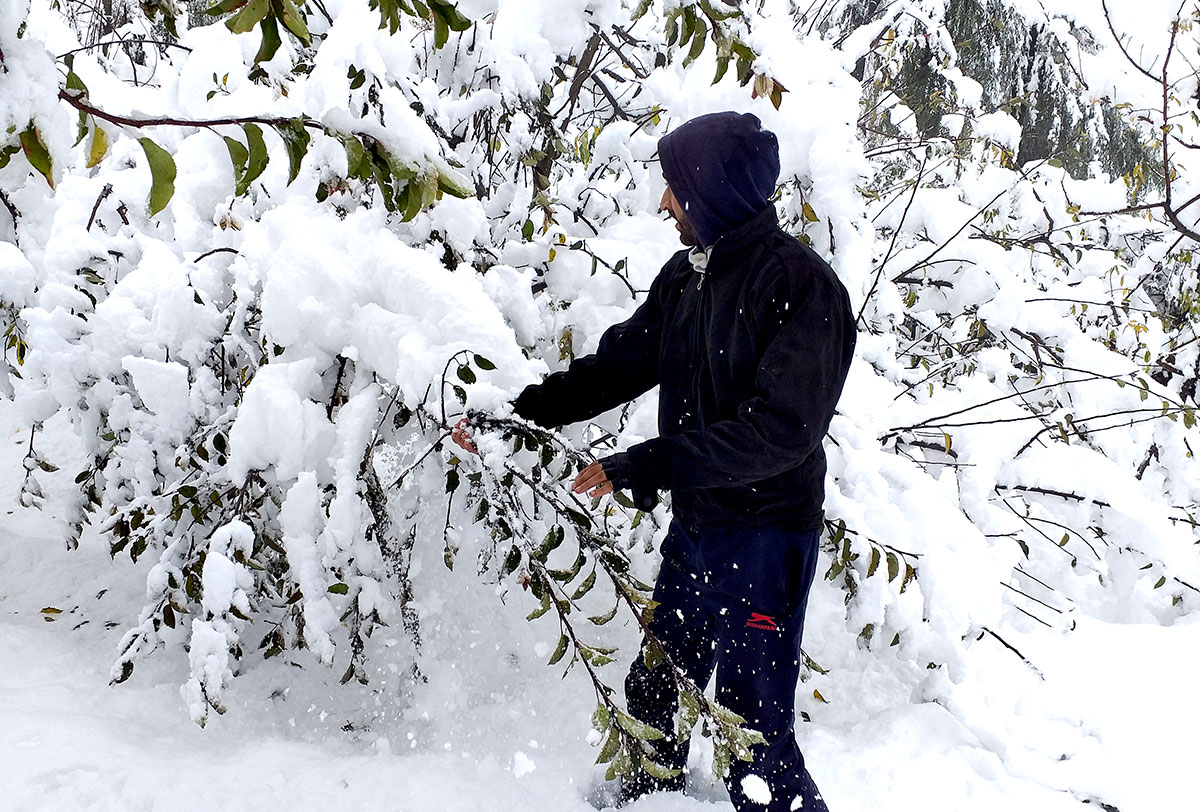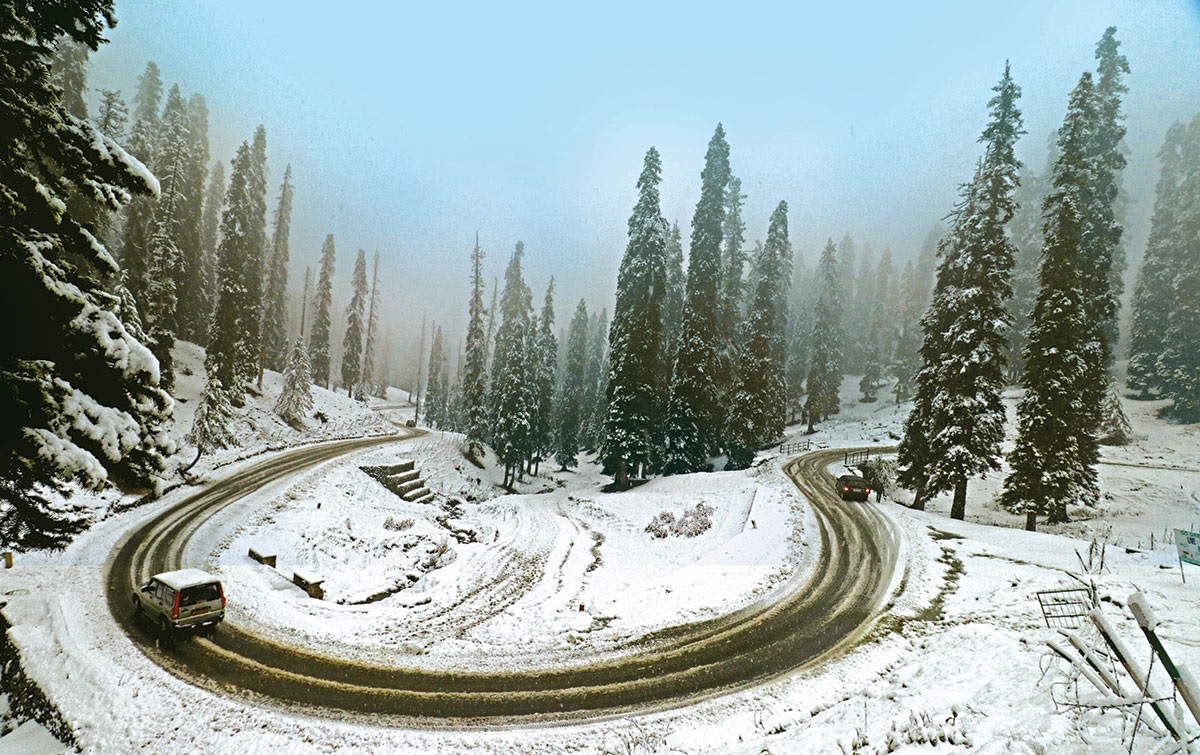As Kashmir was heading towards completing 100 days under restrictions and lockdown, an early snowfall pushed the Valley into yet another crisis at huge costs to human life and its fragile apple economy, reports Masood Hussain

After years of crises dictated by the frequency of ‘dry winter’ conditions, Kashmir is gradually shifting to a new normal – early winters. In 2018, season’s first snowfall came on November 3, damaging seriously almost half of the apple orchards across Kashmir, mostly with the crop still awaiting harvest. This year, it came three days later on November 6, almost creating the same catastrophe. Though most of apple crop was harvested weeks ahead of the heavy snowfall, growers in certain areas down south were waiting for a rainfall to improve the quality of their crop but were caught in the snow. They lost of the trees as well as the crop they were bearing.
“It was a much serious crisis in comparison to last year,” Hashmat Yousuf Qazi, the Chief Engineer Power Development Department (PDD), Kashmir, said. “On the very first day, we rescued our supply lines from around 500 odd trees that had fallen over them. We still have more than this to manage after two days of hard work in the city and its immediate periphery.”
Of the thirteen people including two soldiers and three labourers working for the army, who were killed in situations created by the snowfall, PDD also lost an inspector, Manzoor Ahmad, while restoring the supplies in Srinagar city. Qazi personally had a providential escape when a part of a Chinar fell under the weight of the snow. “This year the snow was heavier than last year and the foliage was still green. This added to the crisis.” Qazi said. Chinar were the main tension for his department in the city. In the periphery, poplars were the principle contributors to the mess.
Unlike the city where the power and water supply got seriously disrupted and movement was paralysed for one full day, the real big crisis was in the periphery – in the apple orchards. Like last year, the destruction is massive. Reports from the countryside suggest most of the orchards survived with almost half of the trees severely damaged. The destruction is seen everywhere from south to north Kashmir. While most of the apple trees split equally, a section was uprooted. Apple growers say they have rediscovered the last year practice of band-aiding the orchards.
“I spent most of the day (Thursday) in the orchard, clearing the snow on the branches,” Waseem Ahmad, a Shopian apple grower said. “But the damage had taken place in the preceding night.”
Interestingly, the trees, which were resurrected last November, were the first to fell victim to the recurrence.
Aijaz Ahmad Bhat, Director Horticulture admitted the massive loss. “Last year, we recorded 28 per cent damage in orchards totalling 43161 hectors and involving 381386 growers,” Bhat said. “This year, our tentative estimation is that it is almost eight per cent more than last year. But we will wait till the survey is over.”
Kashmir grows apple over 210715 hectors of land and the production in 2018 was around 2258899 metric tonnes.
Snow came as the second quick crisis for Kashmir’s apple growers. In wake of the August decision-making by Delhi, the apple was caught in a literal crossfire. As the fugitives started interrupting apple’s traditional cycle, the government jumped in with NAFED on the marketing front. This triggered a chain of murders in south Kashmir.
“By now, we have been able to send almost 80,000 truckloads with around 11.18 million metric tonnes of apple,” Bhat said. “We still have around half of the produce still in Kashmir and will take two more than months.”
Panic dispatches triggered glut in the markets in Delhi and other places triggering a rate fall thus reducing growers margins. They already paid unprecedented freight, that was almost double than 2018, as attacks on drivers triggered a transportation crisis.
NAFED intervention, however, was unimpressive. Officials said it procured slightly more than half a million crates totalling 7561 metric tonnes worth Rs 33.15 crore, so far. Only 1641 growers have sold their produce to NAFED. But the government is keeping this option to stay. Chief Secretary BVR Subrahmanyamhas directed that NAFED will continue procuring the apple for two more months and rates will not be changed.
Bhat said the focus of apple has benefitted the sector. “We have a net gap of almost 3.5 lakh metric tones in controlled atmosphere storage (CAS) in Kashmir,” Bhat said. “The central government has agreed to improve the subsidy component and all the CA stores will now have access to 15 refrigerated vans for exporting the crop and the Centre will subsidise these purchases.” Kashmir has slightly more than one lakh metric tones of CAS facility and most of it is filled up with fresh crop.

Besides, the central government – that is now running the UT directly, is keen to see more high-density orchards. “So far we have 165 hectors of high density orchards and we were recently told that it must reach one lakh hectors in one decade,” one senior official in horticulture department said.
The high-density orchards that offer almost four times increase in the crop and have phenomenally reduced the gestation period are more prone to snow damages. Interestingly, for the second time the November snowfall was heavier and hugely wet.
“One major character of the climatic change is unpredictability,” DrShekeelRamshoo, the most respected earth scientists of Kashmir said. “For the last many years, we are facing weather situation that an element of surprise – snowless winters, dry winters, in a year 620 mm of rainfall that triggered massive floods.”
Ramshoo said the weather shifts that set in around mid-1990s still continue. “In the last 130 years of Kashmir’s recorded meteorological history, the snowfall in normal by end of November but it has been thrice in last 50 years that we got hugely wet snow in the first week of November,” Ramshoo said. “It happened last year and this year but it is very difficult to predict if it will return in 2020.”
The scientist said the early November snowfall has huge snow-water equivalent because of temperature issues like that of late February. “The dry snow that one can sweep takes places only during the Chila-ie-Kalan,” he said.
Outsidethe Alps, Kashmir is the only place that gets powered snow, a key for skiing. Chila-ie-Kalantraditionally marks the beginning of winter on December 21.
The costs that Kashmir’s apple orchards paid for the early snowfall will eventually be known after the survey. But how the UT administration managed its first crisis was visible on Srinagar roads on the very first day.
For the first time, the administration was literally caught napping the whole day on November 7. The snow rain warning was there almost a week in anticipation. On the eve of the snowfall, a snow clearance machine was parked on the Budshah Bridge for most of the day. It indicated readiness of the government. When the machine was eventually required, it somehow went missing.
“There were 19 press notes of the government on November 7, detailing the meetings of officials at divisional and district levels about what they will be doing,” one middle rung officer in the state government said. “But there was not even one press note that would detail what was actually done on the day one.” For the first time, even the LalChowk was impassable as not even this road was cleared of snow.
An official in the Srinagar Municipal Corporation (SMC) said there was no direction about the road clearance “as it used to be”. The road clearance work started on November 8, and within a few hours, most of the city was passable.

This delay had actually let a sentence getting into fierce circulation within the administration. “Jenab Barf Hai, Khud Hei Pigal Jayaygi(Sir, it is snow, will melt automatically),” an officer was alleged to have said to his senior. Nobody knows the veracity of the allegation but it was what happened in most of Kashmir – the wet snow started melting as the weather started improving Friday morning.

The snowfall, however, will continue troubling Kashmir that is already about to complete 100 days of lockdown and protest against the rollback of special status and conversion of the state into two UTs. The highway is already closed because of the frequent shooting stone incident and massive erosions at various places between Banihal and Ramban. Mughal Road also closed because of more than 5 ft snow accumulation in the Pir Ki Gali belt. While this will essentially impact the imports, the serious crisis will be witnessed on the apple export front.
Authorities said they have set in motion in process of surveying the damages to properties. Reports suggest that a good number of houses collapsed in upper reaches of north and south Kashmir.














